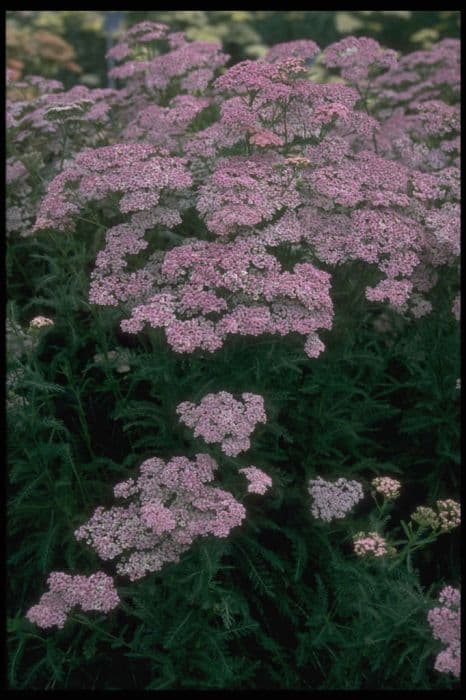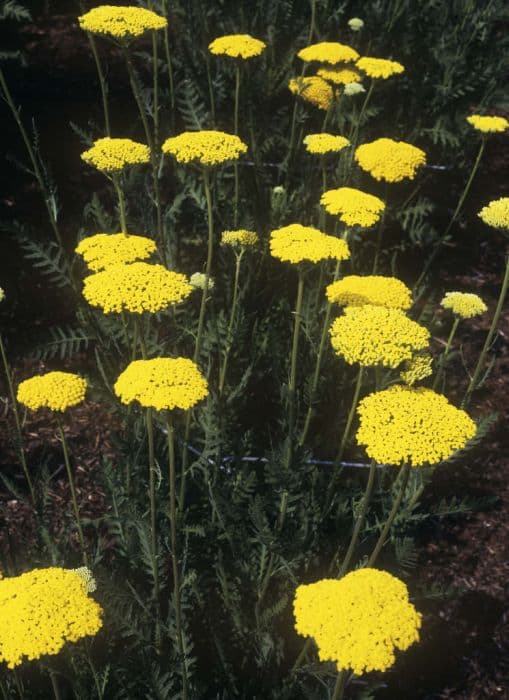Italian Aster Aster amellus 'Framfieldii'

ABOUT
Aster amellus 'Framfieldii', commonly known as the Italian aster, presents itself with a charming display of daisy-like flowers. These blooms are notable for their striking purple petals that radiate around bright yellow centers, like stars in a clear night sky. The petals have a refined, smooth texture and a form that can be described as both open and inviting, somewhat lance-shaped, contributing to a visual feast of color in the garden when the plant is in full bloom. The foliage of the Italian aster 'Framfieldii' is equally attractive, providing a lush backdrop for the vivid flowers. The leaves are often a deep green, with a lanceolate shape that tapers gracefully toward the end, framing the floral display with a verdant flourish. The leaves may appear slightly glossy, with a leathery texture, growing densely to create an appealing mound of greenery from which the flower stems elegantly rise. As for its overall form, the Italian aster 'Framfieldii' creates an impression of a neat, compact bush. Typically, it has a well-branched structure that gives it a full and robust appearance, ensuring that it holds a prominent and pleasing position within the design of any garden or landscape, contributing structure and color without overtaking neighboring plants. Additionally, when the Italian aster 'Framfieldii' enters its blooming period, it becomes a hub of activity, attracting a variety of pollinators, including butterflies and bees. The plant's ability to draw in such wildlife adds a layer of dynamic movement and interest, underlining its importance both as an ornamental and an ecological asset within its setting.
About this plant
 Names
NamesSynonyms
Italian Aster, European Michaelmas Daisy
Common names
Aster amellus 'Framfieldii'.
 Toxicity
ToxicityTo humans
European Michaelmas-daisy is generally not considered toxic to humans. However, as with many plants, it is always wise to watch for individual allergic reactions and to avoid ingesting any part of ornamental plants not meant for consumption.
To pets
European Michaelmas-daisy is not known to be toxic to pets. However, ingestion of any non-food plant can potentially cause gastrointestinal upset such as vomiting or diarrhea in some pets due to the irritation of the stomach or intestines. It is always best to prevent your pets from eating ornamental plants.
 Characteristics
CharacteristicsLife cycle
Perennials
Foliage type
Deciduous
Color of leaves
Green
Flower color
Purple
Height
2 feet (60 cm)
Spread
2 feet (60 cm)
Plant type
Herb
Hardiness zones
5
Native area
Europe
Benefits
 General Benefits
General Benefits- Attracts Pollinators: This plant is known to attract bees and butterflies, which are vital for pollination and maintaining healthy ecosystems.
- Aesthetic Appeal: Aster amellus 'Framfieldii' offers beautiful violet-blue flowers that can enhance the visual appeal of any garden or landscape.
- Low Maintenance: It is relatively easy to care for, requiring minimal watering and care once established, making it suitable for gardeners of all skill levels.
- Drought Tolerant: Once established, it can tolerate periods of dryness, making it a good choice for water-wise gardens.
- Cold Hardy: It is capable of surviving and thriving in colder climates, allowing it to be planted in a variety of geographic locations.
- Long Blooming: This plant has a long blooming period from late summer to fall, providing color and interest in the garden when many other plants have finished flowering.
 Medical Properties
Medical PropertiesThis plant is not used for medical purposes.
 Air-purifying Qualities
Air-purifying QualitiesThis plant is not specifically known for air purifying qualities.
 Other Uses
Other Uses- Aster 'Framfieldii', also known as the European Michaelmas Daisy, can serve as a natural fabric dye, providing a range of subtle colors to textiles.
- When dried, the European Michaelmas Daisy's flowers can be used in a potpourri mix, adding a unique visual element to the combination of dried plants and flowers.
- The plant's stems, when properly treated, can be weaved or incorporated into various crafts such as basketry, providing structural support and aesthetic detail.
- Sturdy and attractive, the dried stalks of the European Michaelmas Daisy can be used in floral arrangements to add texture and height to the design.
- Its flowers can be used in artisanal paper-making processes, embedding petals into the paper for a decorative effect.
- The European Michaelmas Daisy serves as a source of nectar for a DIY butterfly feeder to attract and sustain local butterfly populations in gardens.
- The vibrant colors of the European Michaelmas Daisy can be photographed and used in botanical studies or artistic projects focusing on plant diversity and beauty.
- Aromatic oils from the plant can be extracted and used in creating natural perfumes or scented sachets for closets and drawers.
- Children can engage with the European Michaelmas Daisy in educational gardening projects to learn about plant life cycles and the importance of pollinators.
- The European Michaelmas Daisy's leaves and petals can be used in composting, contributing to a balanced composition of green waste that enriches soil.
Interesting Facts
 Feng Shui
Feng ShuiThe Italian Aster is not used in Feng Shui practice.
 Zodiac Sign Compitability
Zodiac Sign CompitabilityThe Italian Aster is not used in astrology practice.
 Plant Symbolism
Plant Symbolism- Patience: The Aster amellus, commonly known as Italian Aster, is a plant that blooms in late summer to autumn, representing the patience it takes to wait for beautiful things to come to fruition.
- Elegance: With its striking and refined appearance, the Italian Aster symbolizes elegance and the appreciation for the beauty in simplicity.
- Daintiness: The delicate petals of the Italian Aster can convey the idea of daintiness and careful grace.
- Love: The Italian Aster is often associated with love and is given as a symbol of affection, due to its lush, star-shaped flowers.
- Wisdom: In some cultures, the Aster is a symbol of wisdom, through its association with the Greek goddess Astraea.
- Remembrance: The Italian Aster is also seen as a symbol of remembrance, often used in wreaths and memorials to honor those who have passed.
 Water
WaterThe Italian Aster should be watered deeply to soak the root zone and then allowed to dry out slightly before the next watering. This promotes strong root growth. Generally, water once a week with about one gallon of water per plant, but adjust depending on weather conditions and soil type. During hot, dry periods, you may need to water twice a week, whereas in cooler, wetter weather, less frequent watering is required. Overwatering or letting the plant sit in waterlogged soil can lead to root rot, so ensure good drainage.
 Light
LightItalian Aster thrives best in full sun conditions, which means it should receive at least 6 to 8 hours of direct sunlight daily. The ideal spot for this plant would be in an area where it can get the morning sun and some partial shade during the hot afternoon to protect it from scorching.
 Temperature
TemperatureItalian Aster prefers moderate temperatures and can typically withstand a temperature range from 40 to 75 degrees Fahrenheit. However, it can survive brief periods of colder weather, down to about 20 degrees Fahrenheit. The ideal temperate conditions are a consistent range between 50 and 68 degrees Fahrenheit.
 Pruning
PruningItalian Aster benefits from pruning to maintain its shape, promote bushier growth, and remove spent flowers to encourage further blooming. Prune lightly throughout the growing season to deadhead flowers and cut back any leggy stems. Perform a more thorough pruning in late winter or early spring, just as new growth begins.
 Cleaning
CleaningAs needed
 Soil
SoilItalian Aster 'Framfieldii' thrives in well-draining, loamy soil with a neutral to slightly alkaline pH between 6.0 and 7.5. A mix of two-thirds garden soil and one-third grit or coarse sand can create an ideal environment for its root system.
 Repotting
RepottingItalian Aster 'Framfieldii' generally does not require frequent repotting and can be done every 2-3 years to refresh the soil, provided it's growing in the ground or a large enough container.
 Humidity & Misting
Humidity & MistingItalian Aster 'Framfieldii' is tolerant of a wide range of humidity levels and typically thrives in average outdoor humidity without the need for specific adjustments.
 Suitable locations
Suitable locationsIndoor
Provide bright light, well-draining soil, and moderate watering.
Outdoor
Plant in full sun, well-drained soil, and water regularly.
Hardiness zone
5-9 USDA
 Life cycle
Life cycleAster amellus 'Framfieldii', or the European Michaelmas Daisy, begins its life as a seed that germinates in spring, typically after stratification which simulates winter conditions. Upon germination, the seedling develops a root system and foliage, growing into a young plant during the summer with its distinctive lance-shaped leaves. The plant reaches maturity by late summer or early autumn, at which point it produces flower buds that bloom into star-shaped violet-blue flowers, attracting pollinators. After pollination, the flowers develop into seed heads, releasing seeds for new plants to begin the cycle anew. As a perennial, the European Michaelmas Daisy dies back to its root system in winter where it remains dormant until the warming temperatures of spring stimulate new growth. With appropriate care, this cycle continues for several years, as perennials can live for a long duration.
 Propogation
PropogationPropogation time
Late summer
Aster amellus 'Framfieldii', commonly known as the Italian aster, is propagated most effectively by division. This method is best performed in spring, just as the new growth begins to emerge. To propagate, you should carefully lift the plant from the ground with a spade, ensuring a good amount of root and shoot on each piece. Once lifted, divide the clump into smaller sections by gently teasing apart the roots or using a sharp knife to cut them into several pieces, each with at least one growth point. Replant the divisions promptly in well-drained soil, spacing them about 18 inches (approximately 45 centimeters) apart to encourage healthy growth. Water the new plantings thoroughly to help establish them. This method of propagation is quick, preserves the characteristics of the parent plant, and helps to rejuvenate older clumps that may have become woody or less vigorous.









